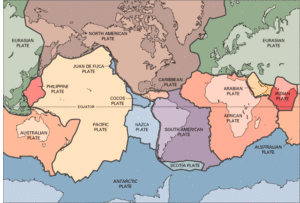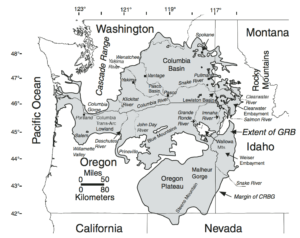 Last night I got to teach my first iteration of my Ecoregions of Oregon class for the year. This is the one class where I really get to delve into Pacific Northwest geology, at least for two and a half hours. While I start with a basic overview of ecoregions and how they fit into the wider scope of biogeography, my favorite section is in the middle because it allows me to show off some of the really cool geological phenomena that shaped the region as we know it today. The topic I probably get the most excited about is that of the ancient Oregon floods of lava and water.
Last night I got to teach my first iteration of my Ecoregions of Oregon class for the year. This is the one class where I really get to delve into Pacific Northwest geology, at least for two and a half hours. While I start with a basic overview of ecoregions and how they fit into the wider scope of biogeography, my favorite section is in the middle because it allows me to show off some of the really cool geological phenomena that shaped the region as we know it today. The topic I probably get the most excited about is that of the ancient Oregon floods of lava and water.
Okay, to be fair, this covers both Washington and Oregon, but because the class is specific to the latter state, that’s going to be my main focus here as well. The Oregon we know today came to be thanks to two separate sets of massive floods–one of molten rock, and one of glacial meltwater. You can’t really get two more different extremes than that!
Today I’m going to talk about the first set of floods, the massive outpourings of molten rock that became the Columbia River Basalt Group.
Hot! Don’t Touch!

The Pacific Northwest has been a very geologically active area for many millions of years, to include a lot of volcanic activity. We’re close to the Cascadia Subduction Zone, which is where the ocean’s crust is diving beneath (subducting) the North American continental plate. Subduction is one of the two most common tectonic activities associated with volcanic and related activity (the other is when you have two plates pulling apart from each other.) And you see a lot of this activity all around the Pacific Ring of Fire, which almost entirely surrounds the Pacific tectonic plate. (Incidentally, it is the much smaller Juan de Fuca plate that is being squeezed between the Pacific plate and the North American one, causing what’s left of it to be progressively subducted back into the magma below the Earth’s crust.) Our big, impressive mountain ranges like the High Cascades, as well as their older cousins the Western Cascades and Coast Range, were all created through related activities like volcanoes and uplift.

Another significant geological phenomenon in the Pacific Northwest is the Yellowstone Hotspot. A hotspot is a place in the Earth’s mantle that displays much higher temperatures than normal. This may be caused by upwellings of extra-hot molten material from deeper in the Earth, or it might be the mantle just under the crust heating up from increased convection. And it’s one of the volcanic phenomena that isn’t necessarily situated near the edge of a tectonic plate; in fact, a hotspot can form literally anywhere on the planet.
Now, this hotspot wasn’t always located under what is today Yellowstone National Park. As the North American plate moved slowly west, the hotspot “moved” east (northeast, to be specific.) Around 15-17 million years ago, the hotspot was located where the border between Oregon and Nevada is today, slowly shifting toward the tri-state boundary that also includes Idaho. It’s in this time where we see the beginning of the floods of lava that would become the Columbia River Basalt Group.
Floods of Lava
 There wasn’t one single place where floods of lava boiled up out of the ground. Rather, it escaped through multiple dikes that stretched in a rough line from northern Nevada, through eastern Oregon and the very western edge of Idaho, and well into western Washington. They weren’t as explosive as, say, a stratovolcano, but the advancing roils of lava could certainly wreak havoc as they moved across the land, incinerating everything in their path. Over time these floods covered most of eastern Oregon and Washington, and traveled by way of the Columbia River all the way to the Pacific Ocean; you can still see basalt cliffs on the coastline that were formed from lava that originated in deserts hundreds of miles to the east. Some of the fastest-moving flows could have traveled from the desert to the coast in the space of a week.
There wasn’t one single place where floods of lava boiled up out of the ground. Rather, it escaped through multiple dikes that stretched in a rough line from northern Nevada, through eastern Oregon and the very western edge of Idaho, and well into western Washington. They weren’t as explosive as, say, a stratovolcano, but the advancing roils of lava could certainly wreak havoc as they moved across the land, incinerating everything in their path. Over time these floods covered most of eastern Oregon and Washington, and traveled by way of the Columbia River all the way to the Pacific Ocean; you can still see basalt cliffs on the coastline that were formed from lava that originated in deserts hundreds of miles to the east. Some of the fastest-moving flows could have traveled from the desert to the coast in the space of a week.
Eventually the lava cooled, becoming basalt. Some of the basalt formed distinctive columns; the centers of the columns cooled and shrunk, drawing surrounding lava into the space left behind, and if the cooling was relatively even they formed the characteristic shapes. Basalt is rather fine-grained, and usually black, brown, or dark gray in color. Because the floods of lava here were extruded out onto the surface, rather than intruding into spaces under the surface, they created what is known as extrusive rock. Extrusive rock cools more quickly than intrusive, and so it doesn’t have enough time to form larger crystals, such as those found in intrusive rocks like granite.
 Scientists studying layers of basalt have found evidence for over three hundred individual floods of lava from the Columbia River Basalt Group, starting 17 million years ago; the bulk of them occurred over the next two million years, but the most recent date from about six million years ago. There are many places where erosion has created outcroppings composed of many distinct layers of basalt, each from a different flow.
Scientists studying layers of basalt have found evidence for over three hundred individual floods of lava from the Columbia River Basalt Group, starting 17 million years ago; the bulk of them occurred over the next two million years, but the most recent date from about six million years ago. There are many places where erosion has created outcroppings composed of many distinct layers of basalt, each from a different flow.
Aftermath
 Eventually the floods of lava ceased, as the Yellowstone Hotspot continued its trajectory east. But they left a landscape deeply changed, with large portions of older geology buried in thousands of feet of basalt. In places you can even still see intrusive dikes, the plugs of basalt that formed when the slowing lava cooled before it could flow onto the surface, sealing the fissure.
Eventually the floods of lava ceased, as the Yellowstone Hotspot continued its trajectory east. But they left a landscape deeply changed, with large portions of older geology buried in thousands of feet of basalt. In places you can even still see intrusive dikes, the plugs of basalt that formed when the slowing lava cooled before it could flow onto the surface, sealing the fissure.
However, geology is always changing and shifting, even if its timetable seems slow to us. Next week I’ll talk about the glacial floods that not only carved into the ancient basalt layers, but left us with many of the geological features we recognize along the Columbia today.
